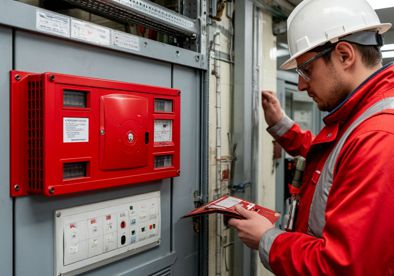Home / Articles / Common mistakes in the installation of fire safety systems and ways to prevent them
Common mistakes in the installation of fire safety systems and ways to prevent them

Fire safety systems are a key element of protecting facilities from fires and the consequences associated with fires. Even if there is a competent project, errors at the installation stage can lead to system malfunction at a critical moment. Below we will look at the most common mistakes when installing fire safety systems and ways to prevent them.
1. Non-compliance with project documentation
Error: Installation is performed without following the approved project exactly, for example, the location of the equipment, the type of cables, or the traces are broken.
Risks: The logic of the system is disrupted, the detection efficiency is reduced, failures or false alarms are possible.
Solution: Strict execution of installation work in accordance with the working documentation. All deviations must be agreed with the designer and reflected in the executive documentation.
2. Poor-quality connections and switching
Error: Use of twists, unreliable terminals, lack of soldering or crimping, violation of labeling.
Risks: Circuit breakage, signal instability, equipment failure.
Solution: The use of professional mounting tools, the use of certified connecting elements, checking all circuits with an ohmmeter and marking all cables according to the scheme.
3. Violation of cable laying requirements
Error: Laying the cable near power lines, without protective pipes, in areas of possible mechanical damage.
Risks: Impact on low-current signals, insulation damage, short circuits.
Solution: Observing the distances between cables of different systems, using cable ducts, metal hoses, and protective boxes. Following SP 6.13130 and PUE.
4. Incorrect installation of the detectors
Mistake: Detectors are installed too close to ventilation grilles, fixtures, windows, or in “dead” areas of the room.
Risks: Delay or inability to detect a fire, false alarms.
Solution: Calculation and placement of sensors according to SP 484.1311500.2020 and equipment certificates. Conducting smoke and heat tests after installation.
5. Lack of grounding and backup power
Error: Ignoring grounding requirements when connecting equipment, saving on uninterruptible power supplies (UPS).
Risks: Damage to equipment during power surges, failure during power outage.
Solution: Installation of a ground loop in accordance with the PUE and SNiP, mandatory installation of a UPS with sufficient autonomy.
6. Lack of testing and adjustment
Error: The system is put into operation without a comprehensive check and setting of operating modes.
Risks: Undetected defects, inconsistencies in the logic of operation, inconsistencies with other engineering systems (notification, ventilation, elevators).
Solution: Start-up and commissioning works with full logging. Mandatory testing of all circuits, modules, and operating scenarios.
7. Violation of the rules of delivery and acceptance
Error: The object is being rented without executive documentation, acts of hidden work, certificates for equipment.
Risks: An operating permit will not be obtained, fines and the need for alterations are possible.
Solution: Maintaining a complete documentation package during the installation process. Verification of all regulatory requirements before handing over the facility.
Conclusion
Errors in the installation of fire safety systems are not just technical flaws, but a potential threat to life, health and property. Problems can be avoided if qualified specialists are involved, high-quality materials are used and the regulatory framework is strictly observed. Remember: the correct installation of the system depends on its reliability in an emergency situation.
| Order installation of fire safety systems
15.05.2025
506 👁